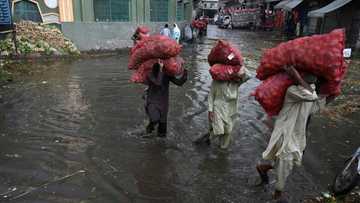Worst natural disasters in South Africa: where and when did they occur?
Natural disasters are catastrophic events with hydrological, geological, or atmospheric origins that usually occur with little or no warning and lead to extensive damage to the environment, human-made structures, and at times, loss of life. These disasters come in numerous forms, some of the most common being floods, tornadoes, wildfires, earthquakes, and droughts. Like in many other countries worldwide, there have been numerous natural disasters in South Africa over the years.
New feature: Check out news exactly for YOU ➡️ find “Recommended for you” block and enjoy!

Source: UGC
South Africa's geographical location makes it prime ground for various natural disasters. This has much to do with its proximity to the Atlantic and Indian oceans and its mountainous landscape.
The worst natural disasters in South Africa
Here is a look at South Africa's eight worst natural disasters.
The Sobantu floods of 1987
In 1987, South Africa experienced one of the worst natural disasters in South Africa in terms of human loss, with more than 500 deaths. The floods originated from a low-pressure cut-off zone that gradually moved across the country, fueled by increased moisture levels in the Southeast.
PAY ATTENTION: Click “See First” under the “Following” tab to see Briefly News on your News Feed!
From September 25, 1987, parts of Kwa Zulu Natal province received close to 1000 mm of rainfall in five days. That is close to what most regions get in a whole year. The heavy rainfall in mountainous areas resulted in flash floods and landslides, causing the loss of hundreds of lives.
In addition, the water levels in the Umgeni River rose so high that the river washed away an entire island.
The floods and landslides of 2022

Source: UGC
This was one of the most recent natural disasters in South Africa in 2022. Severe flooding and landslides hit South Africa from April 11 to April 13. These resulted from extremely heavy rainfall in most parts of the country.
Combined, the floods and landslides caused the death of 448 people and displaced more than 40,000 people. Additionally, more than 12,000 houses in the country's southeast part were destroyed.
On April 18, South Africa's president declared a national state of disaster due to the floods' severity.
The drought of 2018
In 2018, South Africa experienced its worst drought in recorded history. While the drought began about two years earlier, it reached its peak in 2018. Some regions in the country experienced soaring temperatures and inadequate rainfall from 2015 to 2018. As a result, crops failed, and hundreds of thousands of cattle and wildlife died.
By 2018, Cape Town was dangerously close to what is known as a Day Zero disaster. Had the city reached that point, the millions of residents who live there would have been without running water.
The Tulbagh earthquake of September 1969
In September 1969, the country was hit by an earthquake measuring 6.3 on the Richter Scale. The earthquake happened in the Tulbagh area in the Western Cape, resulting in extensive infrastructural damage. There were also numerous fatalities, including children. Some of the other affected towns include Wolseley and Ceres.
The earthquake was the result of a strike-slip fault movement.
The hailstorm of 1936

Source: UGC
In 1936, a disastrous hailstorm struck Limpopo, killing hundreds of cattle and at least ten people. Another nine people reportedly died from the floods that followed the hailstorm. According to reports, the sudden hailstorm had hailstones the size of fully-grown coconuts. Within a few minutes, the hailstorm had caused extensive damage to property and livestock.
The Eastern Cape tornado of 1998
In January 1999, a ferocious F4 tornado tore through the areas around Tabankulu and Mount Ayliff. The tornado left 95% of residents in those areas homeless. The disaster also resulted in extensive property damage, with vehicles being flung as far as 500 meters. More than 20 people perished in the disaster.
The Cape storm of 2017
In June 2017, an unusually massive Southern Atlantic storm struck South Africa's south coast. The storm came amid winds with speeds as high as 120 km/hr. In the ocean, waves as high as 12 meters were recorded. The Cape storm caused eight deaths and extensive damage to more than 100 schools across the country's western cape.
Additionally, more than 700 homes were extensively flooded in the wake of the storm. Surprisingly, the storm did little to alleviate the then Cape Town water crisis despite bringing more than 50 mm of rainfall.
The Knysna wildfires of 2017

Source: UGC
The Knysna Fires of 2017 were the most destructive in the history of South Africa's wildfires. The fires began in early June 2017, fueled by the strong winds from the Cape storm. The winds, blowing at more than 90 km/hr, made it incredibly difficult to contain the fire.
By the time the Knysna fires were extinguished, they had displaced more than 10,000 people and destroyed over 600 houses.
What natural disasters happen in South Africa?
South Africa has recorded more natural disasters than any other African country since 2012. what natural disasters occur in South Africa? Some of the most common ones include flooding, storms, drought, and persistent lightning strikes off the Indian and Atlantic Ocean coastlines.
What was the biggest natural disaster in Africa?
The 1983 drought in Ethiopia was the worst natural disaster in Africa. The drought resulted in the deaths of more than 300,000 people and attracted global attention. Other notable ones include the droughts in Sudan (1983), Mozambique (1981), and Somalia (1973), which resulted in 150,000, 100,000, and 19,000 deaths, respectively.
What are the 10 most common natural disasters?
The most common natural disasters in the world are drought, floods, wildfires, earthquakes, storms, tornadoes, cyclones, hailstorms, volcanic eruptions, and heat waves.
What are the main 3 natural disasters?
Floods, earthquakes, and cyclones are the three disasters responsible for the highest number of deaths.
Over the years, there have been numerous natural disasters in South Africa, all with varying amounts of damage and casualties. Droughts and floods particularly stand out among the rest.
READ ALSO: What are the 15 most expensive cities in Africa in 2022?
Briefly.co.za recently published a list of the most expensive African cities. The continent has undergone drastic changes and development in the past few decades, with various countries and cities emerging as economic, financial, and tourism powerhouses.
As African nations develop, living standards and the cost of living in some of their cities continue to rise. Today, some African cities are as expensive as their European, Asian, or American counterparts. Some of the contributing factors include the cost of housing, transport, health, and education.
New feature: check out news exactly for YOU ➡️ find "Recommended for you" block and enjoy!
Source: Briefly News

Kelly Lippke (Senior Editor) Kelly Lippke is a copy editor/proofreader who started her career at the Northern-Natal Courier with a BA in Communication Science/Psychology (Unisa, 2007). Kelly has worked for several Caxton publications, including the Highway Mail and Northglen News. Kelly’s unique editing perspective stems from an additional major in Linguistics. Kelly joined Briefly News in 2018 and she has 14 years of experience. Kelly has also passed a set of trainings by Google News Initiative. You can reach her at kelly.lippke@briefly.co.za.

Jackline Wangare (Lifestyle writer) Jackline Simwa is a content writer at Briefly.co.za, where she has worked since mid-2021. She tackles diverse topics, including finance, entertainment, sports, and lifestyle. Previously, she worked at The Campanile by Kenyatta University. She has more than five years in writing. Jackline graduated with a Bachelor’s degree in Economics (2019) and a Diploma in Marketing (2015) from Kenyatta University. In 2023, Jackline finished the AFP course on Digital Investigation Techniques and Google News Initiative course in 2024. Email: simwajackie2022@gmail.com.






